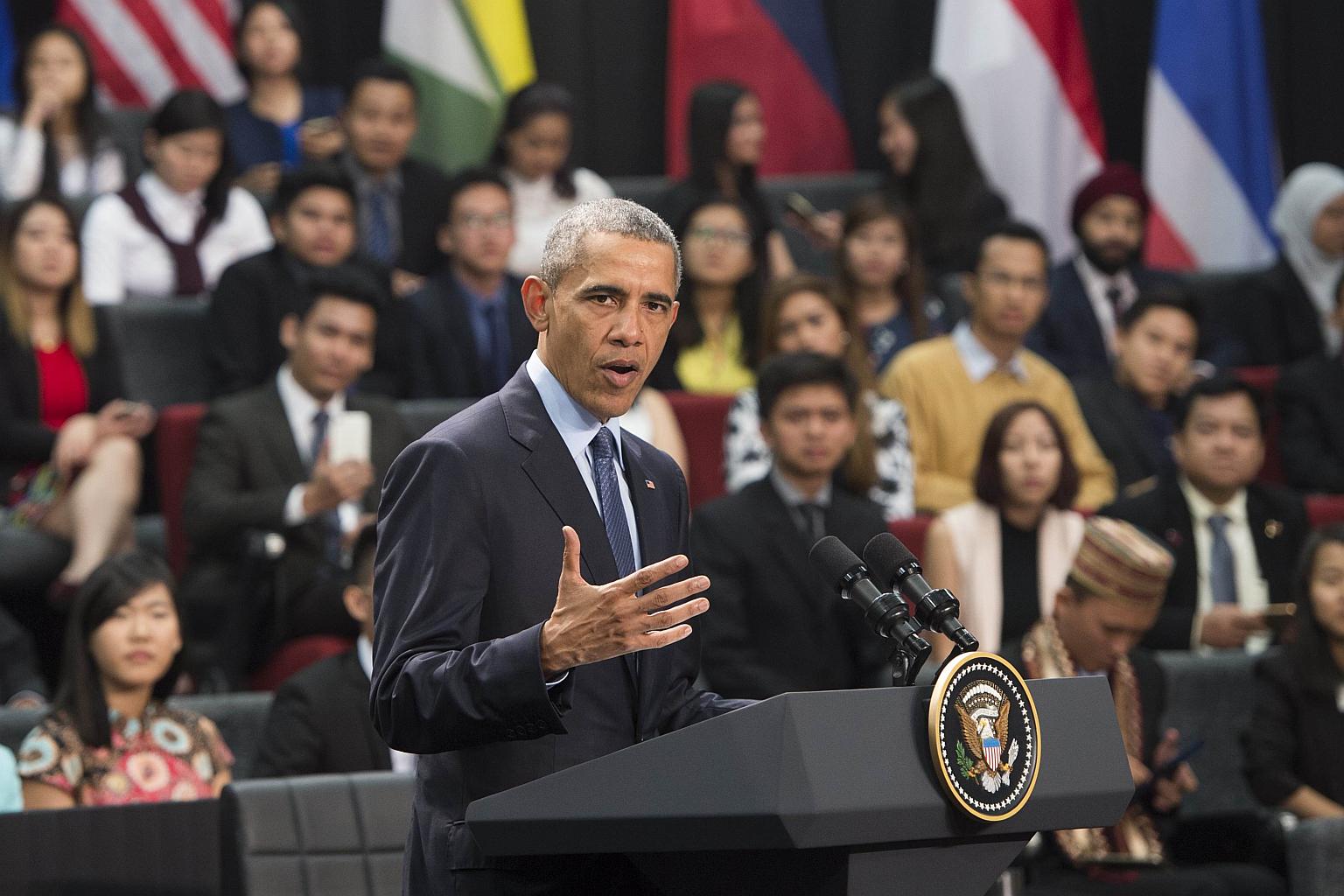The US and South-east Asia: A State of the Union worth sharing: The Nation columnists
Sign up now: Get insights on Asia's fast-moving developments

Mr Barack Obama speaks during a town hall with Young Southeast Asia Leaders Initiative (YSEALI) at Taylor's University in Kuala Lumpur.
PHOTO: AFP
Follow topic:
The region holds the key to America's future economic health and security, and hunger for a return of strong US leadership.
By Curtis S Chin and Jose B Collazo
The Nation/Asia News Network
In his seventh and last State of the Union speech this past week, US President Barack Obama asked Americans to ponder the economic and security challenges the United States is facing.
The president was decidedly upbeat. Americans, though, may well have had reason to pause.
The December shootings in San Bernardino, California, just weeks earlier were the worst terrorist attack in the United States since September 11, 2001. And the latest Rasmussen Reports survey has 67 per cent of Americans now saying their country is headed in the wrong direction.
Yet, President Obama declared, "I stand here confident as I have ever been that the State of our Union is strong." And relative to much of the world, the US economy remains so.
Unfortunately, an important message and geography lesson went missing amidst the rhetoric. It was an opportunity missed for an administration that has added the phrase "Asia pivot" to the geopolitical conversation.
That's shorthand for a rebalance of US attention away from conflicts in Iraq and Afghanistan.
Americans could well have benefited from Mr Obama's taking a moment to underscore how strengthened trade and security relations with the dynamic economies of South-east Asia will help the United States meet economic and security challenges.
In his address to Congress, Mr Obama mentioned China specifically and Asia broadly, as he has in past years.
Yet, while Myanmar and the Philippines have been mentioned in prior addresses, South-east Asia as a region has never caught the full attention of the presidential speechwriters.
The region may well have expected a shout-out from a president who spent part of his childhood in Indonesia - South-east Asia's most populous country and largest economy.
Mr Obama did mention Vietnam in his final remarks, but it was to remind Americans of their nation's difficult wartime legacy in that country. He looked to South-east Asia's past, not its dynamic future. "We… can't try to take over and rebuild every country that falls into crisis, even if it's done with the best of intentions," Mr Obama said.
"That's not leadership; that's a recipe for quagmire, spilling American blood and treasure that ultimately will weaken us. It's the lesson of Vietnam."
How many in the United States would be surprised to know that this one-time enemy is now a significant American trading partner - and one seeking closer US ties amidst China's increasing assertiveness in the South China Sea.
Few likely also know that Thailand is the oldest ally of the United States in Asia, by virtue of a Treaty of Amity and Cooperation signed in 1833.
And Singapore remains a strong security partner of the United States.
Americans would have benefited from knowing that Mr Obama - described by some as America's first "Pacific President" - had invited Vietnamese Prime Minister Nguyen Tan Dung, along with leaders of the nine other Asean member-countries, to a summit in California next month.
Americans would also benefit from learning more of how a recently upgraded and largely welcomed US "strategic partnership" with nations in the region can lead to greater cooperation on economic and security issues.
Already, there is more US investment in the 10 member nations of Asean than in all the BRIC nations of Brazil, Russia, India and China, according to the US-Asean Business Council.
The United States may well be striving to "remake" an international system to ensure greater economic and military security. That new system must engage and include the nations of South-east Asia - described by Mr Obama as being "critical to security, prosperity and human dignity around the world" last November at a US-Asean Meeting held in Kuala Lumpur.
The mutual benefits and opportunities of US-South-east Asian partnership will become even more apparent to individuals and businesses in the near future as the just-launched Asean Economic Community gains momentum.
This market of some 600 million people and combined gross domestic product of US$2.5 trillion (S$3.6 trillion) deserved a mention by the US president.
Understandably, Mr Obama's attention turned to the just concluded Trans-Pacific Partnership trade talks as an example of American leadership in Asia. If implemented, that trade initiative would increase US exports by 9.2 per cent, according to the World Bank. It does not, however, include all members of Asean.
"With TPP, China does not set the rules in that region; we do," said Mr Obama, in calling on the US Congress to approve the landmark trade deal. "You want to show our strength in this new century? Approve this agreement."
The president's final State of the Union address revealed an overly cautious approach to Asia amidst the rise of China.
Much of the region, including in South-east Asia, hungers for a return of strong US leadership.
Our hope is that one year from now, the new president - whoever he or she might be -will make clear that America remains staunchly a Pacific economic and military power, and a force for democracy, human rights and good governance.
The 21st century may well be an Asia-Pacific century.
Yet, the State of the US Union is that the United States remains an Asian-Pacific power, and with attention, investment and involvement, it will remain so to the betterment of South-east Asia, the broader region and world.
That's a tale worth telling.
* Mr Curtis S Chin, a former US ambassador to the Asian Development Bank, is managing director of advisory firm RiverPeak Group, LLC. And Mr Jose B Collazo, a South-east Asian analyst, is an associate with RiverPeak Group.

